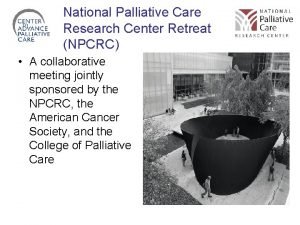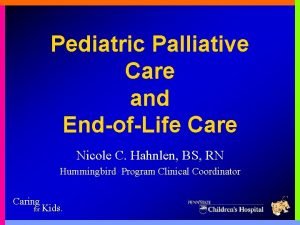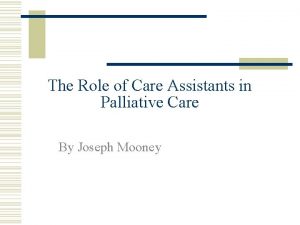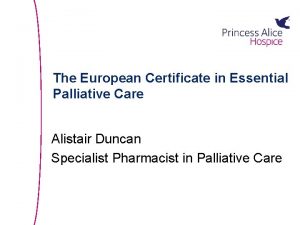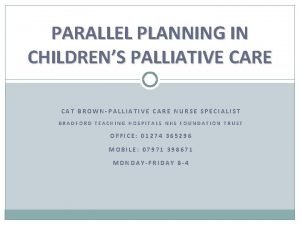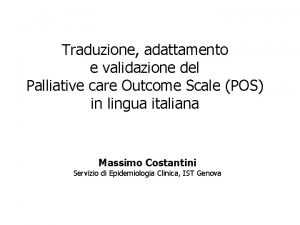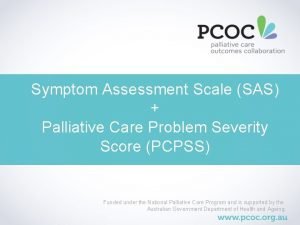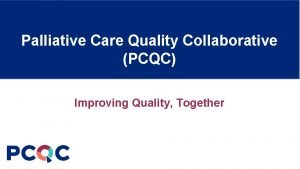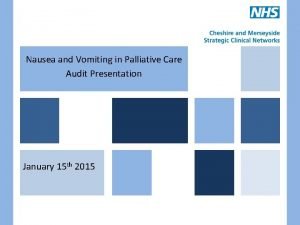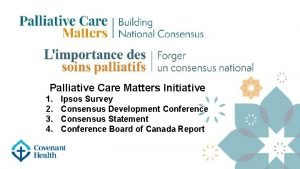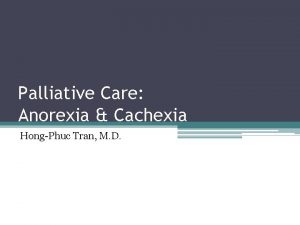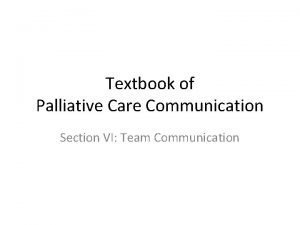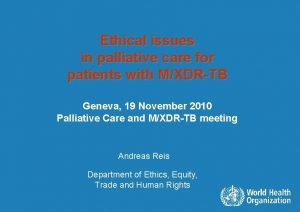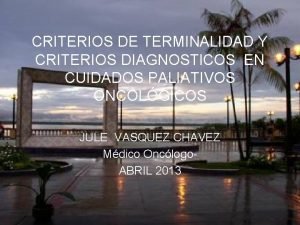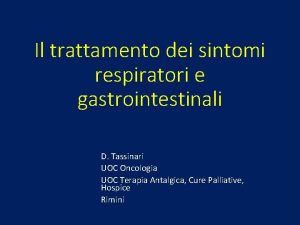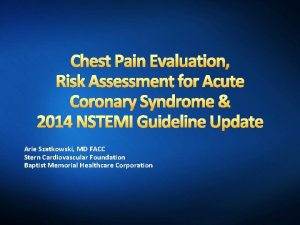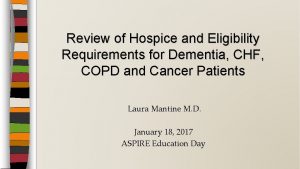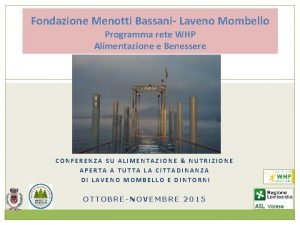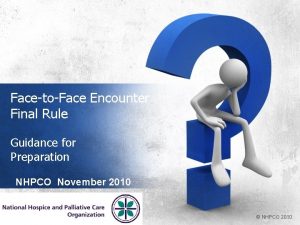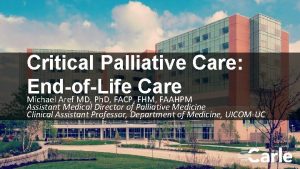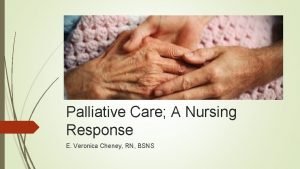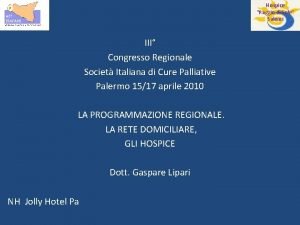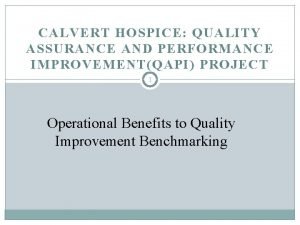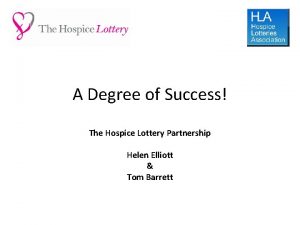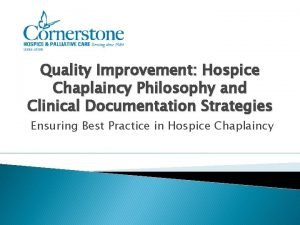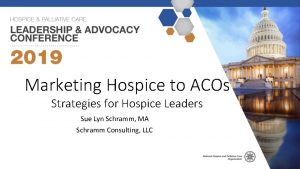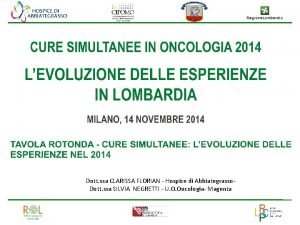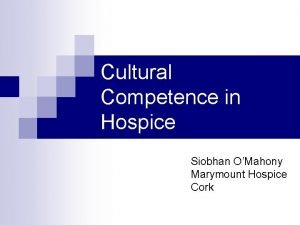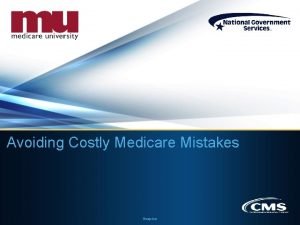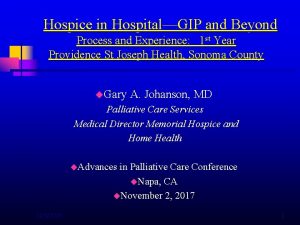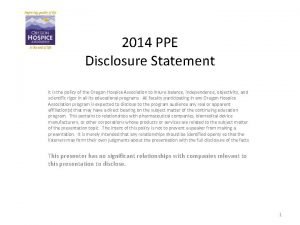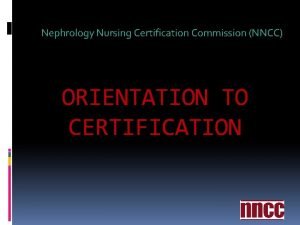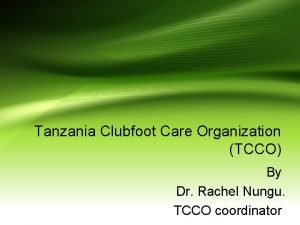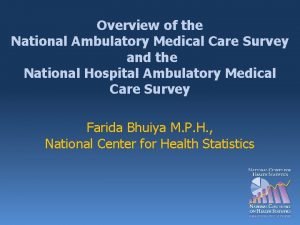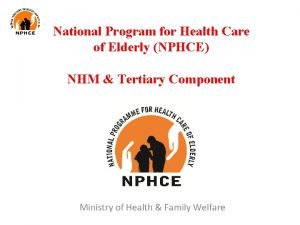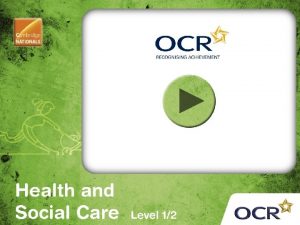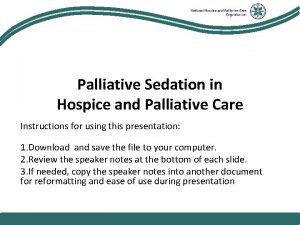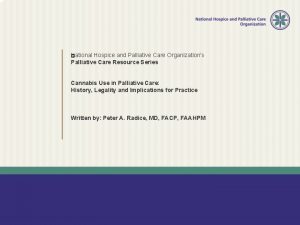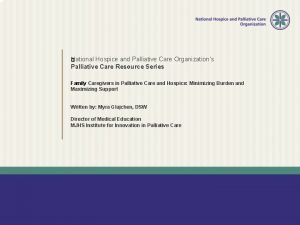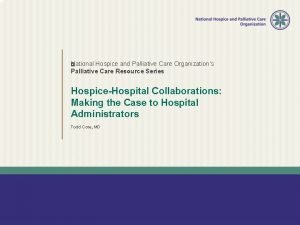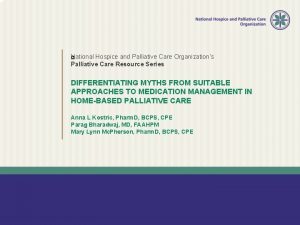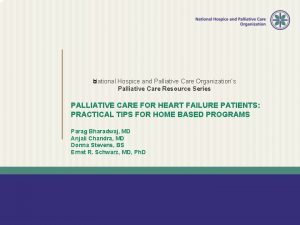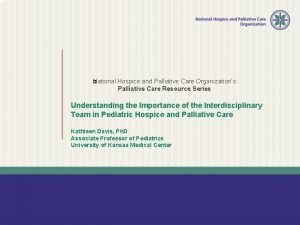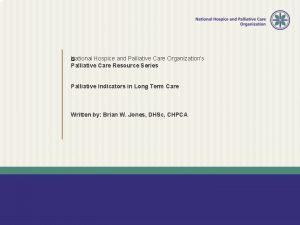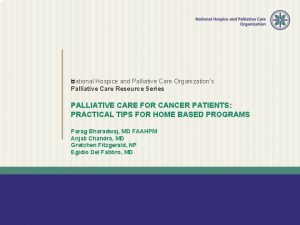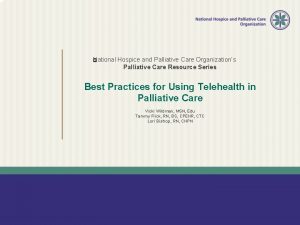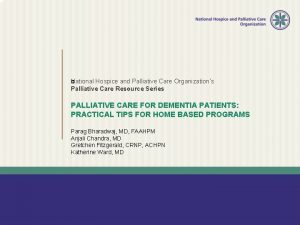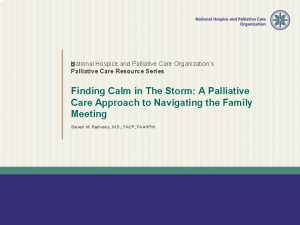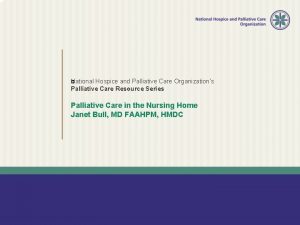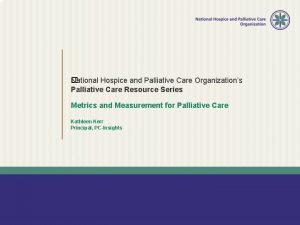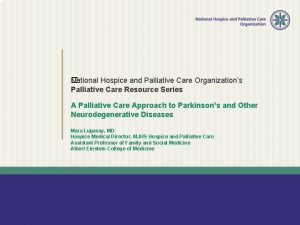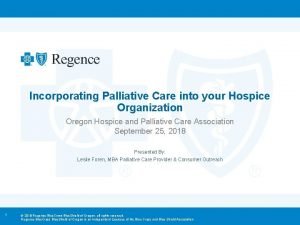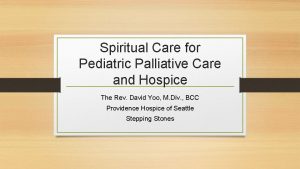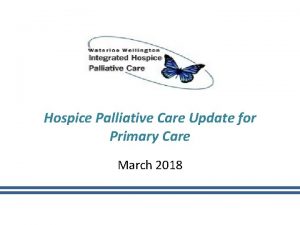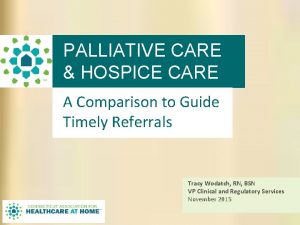National Hospice Palliative Care Organization 25 th Management












































































- Slides: 76

National Hospice & Palliative Care Organization 25 th Management and Leadership Conference Palliative Care Legal Issues Presented by: Connie A. Raffa, J. D. , LL. M. raffa. connie@arentfox. com 212 -484 -3926 Rachel Hold-Weiss, RPA-C, JD weiss-rachel@arentfox. com 212 -484 -3999 April 23, 2010 Washington, DC Arent Fox LLP Washington, DC | New York, NY | Los Angeles, CA © Raffa 1997/2010

PALLIATIVE CARE 2010 NHPCO 2 © Raffa 1997/2010

Palliative Care vs. Hospice Care 1. Hospice Care, defined by 42 CFR § 418. 3, means a comprehensive set of services described in 1861(dd)(1) of the SSA, identified and coordinated by an interdisciplinary group to provide for the physical, psychosocial, spiritual and emotional needs of a terminally ill patient and/or family members, and delineated in a specific patient plan of care. PALLIATIVE CARE 2010 NHPCO 3 © Raffa 1997/2010

Palliative Care vs. Hospice Care 2. Palliative Care, defined by 42 CFR § 418. 3, means patient and family-centered care that optimizes quality of life by anticipating, preventing, and treating suffering. Palliative care throughout the continuum of illness involves addressing physical, intellectual, emotional, social and spiritual needs and to facilitate patient autonomy, access to information and choice. PALLIATIVE CARE 2010 NHPCO 4 © Raffa 1997/2010

Palliative Care vs. Hospice Care 3. Hospice Eligibility requirements – six months or less if illness runs its normal course. § 418. 3 4. Hospice Election requirements – waiver of any Medicare services for terminal illness except hospice care, and services of attending physician, if not employee or volunteer of hospice. § 418. 24 PALLIATIVE CARE 2010 NHPCO 5 © Raffa 1997/2010

Palliative Care vs. Hospice Care 5. Reimbursement streams for hospice. a. Hospice per diem reimbursement for routine, continuous, respite and inpatient hospice care. § 418. 302 and § 418. 306. Payment for physician and nurse practitioner services. § 418. 304 b. No reimbursement per se for palliative care. Revenue streams depend on how palliative care is provided and type of entity. Apply regular reimbursement rules. PALLIATIVE CARE 2010 NHPCO 6 © Raffa 1997/2010

Palliative Care vs. Hospice Care 6. Revenue streams for palliative care. a. Medicare Part A – hospital, outpatient hospital services, certified home health service b. Medicare Part B – physicians, physician assistants, nurse practitioners, psychologists, therapists (PT/OT), DME suppliers c. Medicare Part C – managed care d. Contract relationships between providers e. Private pay, and third party insurance. PALLIATIVE CARE 2010 NHPCO 7 © Raffa 1997/2010

Why Have a Palliative Care Program (PCP)? 1. Clinical Imperative – Need for better quality of care for persons with serious and complex illnesses: a. Relieves physical and emotional suffering. b. Improves patient-physician communication and decision-making. c. Coordinates continuity of care across settings. d. Improves quality of life, satisfaction for patients and their families. Source: www. capc. org PALLIATIVE CARE 2010 NHPCO 8 © Raffa 1997/2010

Why Have a PCP? 2. Compliance With Patient and Family Wishes – What do patients with serious illness want? a. Pain and symptom control. b. Avoid inappropriate prolongation of the dying process. c. Achieve a sense of control. d. Relieve burdens on family and caregivers. e. Strengthen relationships with loved ones. Source: Singer et al. , JAMA 1999; 281(2): 163. 169. PALLIATIVE CARE 2010 NHPCO 9 © Raffa 1997/2010

Why Have a PCP? 3. The Demographic Imperative – Providers need PCP to effectively treat the growing number of persons with serious, advanced and complex illness from the day of diagnosis. a. People deserve better care throughout the multi-year course of advanced illness. b. Additional approaches for chronic, progressive illness, disease-modifying therapies. c. Create an integrated continuum of high-quality palliative and hospice care. PALLIATIVE CARE 2010 NHPCO 10 © Raffa 1997/2010

Why Have a PCP? 4. The Educational Imperative a. b. c. d. e. Improve skills, knowledge, and attitudes towards palliative care, and end of life issues. Medical school and residency curricula are offering palliative care courses. Hospice & Palliative Nurse Association offers certification for RN’s and NP’s. Board Certification in Hospice and Palliative Care offered by the American Board of Medical Specialties (ABMS) Also certification is offered by ABMS if certified by American Boards of Medicine, Anesthesiology, Family Medicine, Physical Medicine and Rehabilitation, Psychiatry, Neurology, Surgery, Pediatrics, Emergency Medicine, Radiology and Obstetrics and Gynecology with specialty in hospice and palliative care. PALLIATIVE CARE 2010 NHPCO 11 © Raffa 1997/2010

Why Have a PCP? The Fiscal Imperative Population aging + growth in number of patients in need + effective new technologies. a. Under DRG system long, high-intensity hospital stays = fiscal crisis for hospitals. b. Palliative care lowers costs for hospitals and payors by reducing hospital and ICU length of stay, and some direct costs. c. Palliative care improves continuity among hospice/homecare/nursing home settings by supporting appropriate transition management. Source: www. capc. org PALLIATIVE CARE 2010 NHPCO 12 © Raffa 1997/2010

Organization Design Options A. B. C. D. E. F. Physician Part B Group Hospice/Hospital Contract to Provide PC Hospice/PC Nurse Liaison in Hospital Managed Care Payment Opportunities Certified Home Health Palliative Care Program Hospice Contract with Hospital or Skilled Nursing Home for Inpatient Hospice Care PALLIATIVE CARE 2010 NHPCO 13 © Raffa 1997/2010

A. Organization Design – Part B Physician Group 1. 2. 3. 4. 5. Physician Part B Palliative Care Practice Hospice Owned Captive Model – Corporate Practice of Medicine Rules Create a separate entity PC or PLLC. Apply for Part B “supplier” number from local Medicare fee for service contractor. National Provider Identification Number. PALLIATIVE CARE 2010 NHPCO 14 © Raffa 1997/2010

A. Organization Design – Part B Physician Group 6. 7. 8. CMS-855 B Medicare Enrollment Application for Medical Group Practice or Clinic that will bill for Medicare Part B services. CMS -855 I Medicare Enrollment Application for Physician and Non-Physician Practitioner CMS-855 R Medicare Enrollment Application for Reassignment of Medicare Benefits. PALLIATIVE CARE 2010 NHPCO 15 © Raffa 1997/2010

B. Organization Design – Hospital Contract Hospice Contracts With Hospital To Provide Palliative Care Specialists 1. Hospital contracts for hospice physicians, nurses, social workers, counselors or for palliative care training. 2. Nurse Practitioners jointly funded. 3. Contract issues apply, i. e. , kickbacks, safe harbors, Stark, costs allocation on cost report. PALLIATIVE CARE 2010 NHPCO 16 © Raffa 1997/2010

C. Organization Design – Nurse Liaison Hospice/ PC Nurse Liaison in Hospital or Nursing Home 1. Contract between hospice and hospital or nursing home to provide a liaison nurse in the facility. 2. Rules for Intake Coordination and Discharge Planning Activities apply. PALLIATIVE CARE 2010 NHPCO 17 © Raffa 1997/2010

C. Organization Design – Nurse Liaison 3. Intake Coordination – manage and facilitate transfer of patients from hospital to hospice or PCP. Occurs only after patient referred by physician to hospice or PCP. a. Explaining hospice or PCP policies to patients and family after referral; b. Establish plan of care prior to hospital discharge; c. Communicate and coordinate post-discharge care. PALLIATIVE CARE 2010 NHPCO 18 © Raffa 1997/2010

C. Organization Design – Nurse Liaison 4. Discharge Planning Type Activities – Screen and review hospital files, individually or during staff or discharge planning rounds, to determine level of care patient will require upon discharge. 5. Discharge planning is hospital’s responsibility pursuant to Medicare conditions of participation for hospitals and paid for in DRG payment. COPs – 42 C. F. R. § 482. 43. PALLIATIVE CARE 2010 NHPCO 19 © Raffa 1997/2010

C. Organization Design – Nurse Liaison 6. Problem: If hospital discharge planner involves liaison before the patient referred to hospice or PCP, the liaison is performing discharge planning. Two issues: a) Potential Kickback – hospital is receiving in-kind contribution of discharge services, thereby being relieved of costs incurred, to induce hospital to make referrals to the hospice or PCP. 42 U. S. C. § 1320 a-7 b(b)(2). PALLIATIVE CARE 2010 NHPCO 20 © Raffa 1997/2010

C. Organization Design – Nurse Liaison b. Cost report issue for hospice because hospital discharge planning activities are not costs related to patient care of a hospice or PCP patient, and subject to disallowance. Including all of liaison’s salary on hospice or PCP cost report could be false claim. PALLIATIVE CARE 2010 NHPCO 21 © Raffa 1997/2010

C. Organization Design – Nurse Liaison 7. Solution a. Does State Law permit delegation of discharge planning functions? b. Liaison leased to hospital for discharge planning services. Contract must meet the Personal Services and Management Contract Safe Harbor under Kickback statute. 42 C. F. R. § 1001. 952(d). In writing, describe services and schedule, term one year or more, FMV, no link to amount of referrals from hospital, not promote violation of federal law, and reasonable business purpose. PALLIATIVE CARE 2010 NHPCO 22 © Raffa 1997/2010

C. Organization Design – Nurse Liaison 7. Solution (cont’d. ) c. Cost report issue – liaison keeps time records on discharge planning activities vs. intake activities to allocate allowable and nonallowable salary and related costs. 8. Provider Reimbursement Review Manual Pub. 15, Section 2113 et al. , home health care coordinators. PALLIATIVE CARE 2010 NHPCO 23 © Raffa 1997/2010

C. Organization Design – Nurse Liaison 9. Education and Liaison Activities are allowable hospice costs if necessary for patient care and do not duplicate services which hospital should supply. Educational resource to hospital concerning hospice and palliative care, training for hospital staff, and consultant to hospital for hospice or palliative care policies and practices. Educate physicians on available hospice/ palliative care services. PALLIATIVE CARE 2010 NHPCO 24 © Raffa 1997/2010

D. Organization Design – Managed Care Payment Opportunities Hospice contracts with managed care plans to provide comprehensive palliative care services under a capitated negotiated rate to covered patients. PALLIATIVE CARE 2010 NHPCO 25 © Raffa 1997/2010

E. Organization Design – CHHA Palliative Care Program 1. CHHA contracts with hospice for nurses and social workers to provide care to CHHA patients. Team approach. 2. Hospice paid by CHHA for contracted personnel through negotiated rate, i. e. , per visit. Program Memorandum A-02 -0102, October 25, 2002. PALLIATIVE CARE 2010 NHPCO 26 © Raffa 1997/2010

E. Organization Design – CHHA 3. CHHA reimbursed under PPS based on Home Health Resource Groups (HHRGs). Reimbursement level depends on patient’s OASIS score assessing clinical severity, functional status (ADLs), and service utilization (PT, OT, Speech Language Pathology). 4. HHRG rates depend on geographic location, where patient is treated. PALLIATIVE CARE 2010 NHPCO 27 © Raffa 1997/2010

E. Organization Design – CHHA 5. Patient must be eligible for home health services under Medicare: confined to home, under physician’s care, in need of skilled services on part-time or intermittent basis, pursuant to plan of care signed by physician, and services provided by CHHA or under arrangement. 42 C. F. R. § 409. 42. PALLIATIVE CARE 2010 NHPCO 28 © Raffa 1997/2010

E. Organization Design – CHHA 6. Medicare requires at least one qualifying service (skilled nursing, physical, speech, continuing occupational therapy, medical social services or home health aide) be provided directly by CHHA employees. CHHA must not contract for hospice service that is qualifying service. 42 C. F. R. § 409. 44 and 484. 14(a) 7. Hospice/CHHA contract should meet safe harbor for personal services against anti-kickback laws, because hospice and CHHA may refer patients to each other. 42 C. F. R. § 1001. 952(d) PALLIATIVE CARE 2010 NHPCO 29 © Raffa 1997/2010

F. Organization Design – Inpatient Hospice Unit 1. Hospitals or Nursing home contracts with hospice to provide inpatient hospice care. Hospice inpatient unit at hospital may also be part of the hospital’s palliative care program. 2. Admission is for pain control, acute management of symptoms that cannot be managed elsewhere; or inpatient respite care for no more than five consecutive days. PALLIATIVE CARE 2010 NHPCO 30 © Raffa 1997/2010

F. Organization Design – Inpatient Hospice Unit 3. Hospice pays hospital negotiated per diem rate. Usually Hospitals won’t contract for Inpatient Respite Care because rate is too low. 4. Hospice still involved in providing services required in plan of care. 5. Cap total number of inpatient days for 12 months can’t be more than 20% of total number of hospice days. PALLIATIVE CARE 2010 NHPCO 31 © Raffa 1997/2010

F. Organization Design – Inpatient Hospice Unit 6. Requirements for Inpatient Hospice Care, § 418. 108(a), for symptom management and pain control must be provided in a Medicare certified hospice that meets the requirements of § 418. 110; or a hospital or SNF that meets § 418. 110(b) and (e), i. e. 24 -hour nursing services and patient areas. 7. For Inpatient Respite Care – 24 -hour RN is no longer required if patients needs are met. § 418. 108(b) PALLIATIVE CARE 2010 NHPCO 32 © Raffa 1997/2010

F. Organization Design – Inpatient Hospice Unit 8. Per 42 C. F. R. § 418. 108(c), contract must at minimum state: a. Hospice gives inpatient provider a copy of the patient’s plan of care, and specifies inpatient services to be furnished; b. Inpatient provider has policies consistent with hospice’s, and agrees to abide by hospice palliative care patient care protocols; c. Hospice inpatient clinical record includes all inpatient services and events: copy of discharge summary given to hospice; and if requested, medical record provided to hospice; PALLIATIVE CARE 2010 NHPCO 33 © Raffa 1997/2010

F. Organization Design – Inpatient Hospice Unit d. The inpatient facility identifies one of their staff who is responsible for implementation of contract terms; e. Hospice retains responsibility to ensure appropriate training of inpatient personnel who provide care pursuant to contract. Description of training and those giving the training are documented; f. Both Parties agree on a method for verifying that requirements of 8 a to e are met. PALLIATIVE CARE 2010 NHPCO 34 © Raffa 1997/2010

Complex Rules Require Expert Legal Analysis Creating a Palliative Care Provider Involves: A. B. C. D. E. F. G. H. State License Laws State Corporate Practice of Medicine Laws Anti-Kickback – Federal and State Laws Physician Self Referral – Federal and State Stark Patient Inducement or Solicitations Laws Fee-Splitting Rules – State Cost Report Rules – Medicare and Medicaid Complex Medicare/Medicaid Reimbursement Rules PALLIATIVE CARE 2010 NHPCO 35 © Raffa 1997/2010

A. Complex Rules – State License 1. What is state definition of hospice care? 2. Is there “wiggle room” for hospice to provide palliative care to patients who are not terminally ill and/or who have not elected hospice care? 3. Does state law define palliative care? 4. Federal requirements - CMS Program Memorandum A-02 -102. 5. Regulator’s interpretation, i. e. , NY Pub Health Law § 4012 -b. PALLIATIVE CARE 2010 NHPCO 36 © Raffa 1997/2010

B. Complex Rules – Corporate Practice 1. Some state laws prohibit a business corporation or lay person from controlling the medical decisions of a physician and professional staff. 2. A business corporation may: a. not employ licensed professionals (physicians, and nurse practitioners); b. have limited contracting opportunities with physicians to provide medical services; and c. not own a Part B physician group. PALLIATIVE CARE 2010 NHPCO 37 © Raffa 1997/2010

B. Complex Rules – Corporate Practice 3. Reason for the rule is to ensure that medical decisions are only made based on what is best for the patient. 4. Some states have a clear prohibition, i. e. , New York. Some states don’t follow rule. Some states law is unclear and case decisions must be reviewed. PALLIATIVE CARE 2010 NHPCO 38 © Raffa 1997/2010

B. Complex Rules – Corporate Practice 5. Why does it matter? If license law permits hospice to have a palliative care program, but you are in a corporate practice of medicine state, the Part B Physician Palliative Care Group cannot be a division of hospice or owned by hospice. 6. Separate Entity – Professional Corporation (PC) or a Professional Limited Liability Corporation (PLLC). PALLIATIVE CARE 2010 NHPCO 39 © Raffa 1997/2010

B. Complex Rules – Corporate Practice 7. Possible solution, if state law has corporate practice of medicine requirements, Part B Palliative Care Group (PCP) set up as a “Captive” Professional Corporation. Hospice enters Management Service Contract with Part B PCP. PALLIATIVE CARE 2010 NHPCO 40 © Raffa 1997/2010

B. Complex Rules – Corporate Practice 8. Management agreement hospice provides: Administrative staff Space / Lease Purchasing Equipment, Supplies Payroll, Bookkeeping, Budget Arrange for Legal and Accounting Contracts Medical Records and HIPAA Data Analysis Computer – IT Compliance Billing Human Resources – recruiting, hiring, credentialing Policies and forms PALLIATIVE CARE 2010 NHPCO 41 © Raffa 1997/2010

B. Complex Rules – Corporate Practice 9. Fair Market Value (FMV) fees for management services. 10. Safe Harbor for personal services and management contract because hospice and Part B PCP can refer patients to each other. 42 C. F. R. § 1001. 952(d) 11. Role of Hospice Medical Director and Part B Group. PALLIATIVE CARE 2010 NHPCO 42 © Raffa 1997/2010

B. Complex Rules – Corporate Practice 12. If hospice management agreement restricts physician’s professional judgment, physician could be sanctioned for “unprofessional medical conduct. ” 13. Evaluate degree to which hospice management controls money flow to Part B PCP. The more control exercised by hospice through, i. e. , budgetary constraints, the more likely the arrangement will violate corporate practice of medicine rules, applicable under some states. PALLIATIVE CARE 2010 NHPCO 43 © Raffa 1997/2010

B. Complex Rules – Corporate Practice 14. Organization documents such as articles of incorporation and bylaws, should be reviewed by health care counsel to ensure physician has sufficient control. Bylaws limiting physician shareholder’s ability to receive distribution from the PC or PLLC may violate corporate practice laws. PALLIATIVE CARE 2010 NHPCO 44 © Raffa 1997/2010

C. Complex Rules – Anti-Kickback Law 1. Federal Criminal Law and some States. 2. Broad prohibition of offer, solicitation, payment or receipt of anything of value (direct or indirect, overt or covert, in cash or in kind) intended to induce referral of patient for items or services reimbursed by all federal programs, including Medicare, Medicaid, and programs covering veterans’ benefits. Social Security Act (SSA) § 1128 B. PALLIATIVE CARE 2010 NHPCO 45 © Raffa 1997/2010

C. Complex Rules – Anti-Kickback Law 3. “One Purpose Test” – Kickback exists if one purpose of payment is to induce referrals, regardless of legitimate purposes. 4. Remuneration is anything of value, money, bribes, rebates, free services. 5. Both the offeror and recipient violate statute. PALLIATIVE CARE 2010 NHPCO 46 © Raffa 1997/2010

C. Complex Rules – Anti-Kickback Law 6. Felony � Maximum $25, 000 fine. � Imprisonment up to 5 years. � Automatic exclusion. � Civil Money Penalties up to $50, 000 and damages up to 3 times the amount of the illegal kickback. PALLIATIVE CARE 2010 NHPCO 47 © Raffa 1997/2010

C. Complex Rules – Anti-Kickback Law 7. Statutory and Regulatory Exceptions or Safe Harbors are voluntary. 8. Safe Harbors describe minimum requirements for different business relationships that, if fully met, assure no criminal or civil sanctions. 9. Failure to Meet a Safe Harbor is not automatically a kickback. Arrangement evaluated on specific facts. PALLIATIVE CARE 2010 NHPCO 48 © Raffa 1997/2010

C. Complex Rules – Anti-Kickback Law 10. Safe Harbors, 42 C. F. R. § 1001. 952. There are 25, including: Discounts Bona fide employment Space rentals Personal service and management contracts Co-insurance and deductible waivers Price reductions for eligible managed care organizations � Electronic health record items and service � � � PALLIATIVE CARE 2010 NHPCO 49 © Raffa 1997/2010

C. Complex Rules – Anti-Kickback Law 11. Fair Market Value generally means price paid in arm’s length transaction, and does not take into account the volume or value of any referrals or business paid by Federal or State. 12. Reasonable Business Purpose. 13. OIG – Advisory Opinion. PALLIATIVE CARE 2010 NHPCO 50 © Raffa 1997/2010

D. Complex Rules – Stark Law 1. Federal Civil Statute and Some States. 2. Federal Physician Self Referral Law: A physician may not refer Medicare or Medicaid patients for designated health services (“DHS”) to an entity with which the physician or an immediate family member has a financial relationship unless an exception applies. 3. An entity may not present a claim for reimbursement from Medicare or Medicaid for services provided as a result of a prohibited referral. SSA § 1877 PALLIATIVE CARE 2010 NHPCO 51 © Raffa 1997/2010

D. Complex Rules – Stark Law 4. Physician: MD, DO, dentist, podiatrist, optometrist, chiropractor. 5. Immediate Family Member: Husband, wife, parent (step), child (step), sibling, in-laws, grandparents or grandchild and spouses. PALLIATIVE CARE 2010 NHPCO 52 © Raffa 1997/2010

D. Complex Rules – Stark Law 6. Financial Relationship: a. b. c. d. Direct or indirect. Ownership or investment interest. By a physician or immediate family. In an entity that furnishes DHS. PALLIATIVE CARE 2010 NHPCO 53 © Raffa 1997/2010

D. Complex Rules – Stark Law 7. Designated Health Services are: a. b. c. d. e. f. g. h. i. j. k. Clinical laboratory services; Physical therapy services; Occupational therapy and speech pathology services; Radiology and certain other imaging services; Radiation therapy services and supplies; Durable medical equipment; Parenteral and enteral nutrients, equipment, and supplies; Prosthetics, orthotics, and prosthetic devices and supplies; Home health services; Outpatient prescription drugs; and Inpatient and outpatient hospital services. PALLIATIVE CARE 2010 NHPCO 54 © Raffa 1997/2010

D. Complex Rules – Stark Law 8. Federal Stark Law contains exceptions to the general self referral prohibition. Referral is not prohibited if exception is met. 9. Stark Law is strict liability statute. If exception is not met, the arrangement is unlawful. PALLIATIVE CARE 2010 NHPCO 55 © Raffa 1997/2010

D. Complex Rules – Stark Law 10. Exceptions apply to: a. Both Ownership/Investment Interests and Compensation Arrangements. (i. e. , physician services, in-office ancillary services, intra-family referrals). b. Only Ownership/Investment Interests. c. Only Compensation Interests. (i. e. , bona fide employment, rental of office space/equipment, personal services arrangements). PALLIATIVE CARE 2010 NHPCO 56 © Raffa 1997/2010

D. Complex Rules – Stark Law 11. Three-Step Analysis under Stark: • • • Is there a referral from a physician for DHS? Does the physician (or an immediate family member) have a financial relationship with the entity providing the DHS service? Does the financial relationship fit in an exception? PALLIATIVE CARE 2010 NHPCO 57 © Raffa 1997/2010

D. Complex Rules – Stark Law 12. Sanctions and Penalties under Stark: a. Denied claims. b. Return reimbursement to Medicaid/ Medicare for paid claims for DHS. c. Civil Money Penalties up to $15, 000 for each service a person “knows or should know” was provided in violation of Stark. d. Exclusion. e. Civil Monetary Penalties up to $100, 000 and exclusion for attempting to circumvent Stark. PALLIATIVE CARE 2010 NHPCO 58 © Raffa 1997/2010

D. Complex Rules – Stark Law 13. Health Care Attorney should analyze business relationships, and referral streams of Palliative Care Programs to ensure all these “Legal Minefields” are safe. 14. Most common safe harbors against kickback are Personal Services Management Contract and Lease. PALLIATIVE CARE 2010 NHPCO 59 © Raffa 1997/2010

E. Complex Rules – Patient Inducement or Solicitation 1. Anti-Inducement Provision: Section 1128 A(a)(5) imposes civil monetary penalties against any person who offers or transfers remuneration to any individual eligible for Medicare or State health care program, that such person knows or should know is likely to influence such individual to order or to receive from a particular provider, practitioner, or supplier any item or service for which payment may be made, in whole or in part, under Medicare or a State health care program. 42 C. F. R. § 1003. 102(b)(13). PALLIATIVE CARE 2010 NHPCO 60 © Raffa 1997/2010

E. Complex Rules – Patient Inducement or Solicitation 2. Remuneration under Section § 1128 A(i)(6) includes transfers of items or services for free or for other than fair market value. 3. Congress did not intend to preclude provision of items and services of nominal value, including, i. e. , refreshments, medical literature, complimentary local transportation services, or participation in free health fairs. H. R. Conf. Rep. No. 104 -736, at 255 (1996). PALLIATIVE CARE 2010 NHPCO 61 © Raffa 1997/2010

E. Complex Rules – Patient Inducement or Solicitation 4. OIG states nominal value no more than $10 per item, or $50 in the aggregate on an annual basis. Frequent rendering of items or services to any individual may preclude such items and services from being classified as nominal in value. 65 Fed. Reg. 24400, 24411 (4/26/00). 5. Special Advisory Bulletin on Gifts and Other Inducements to Medicare or Medicaid Patients issued 8/30/02. http: //oig. hhs. gov/fraud/docs/alertsandbulletins/SABGiftsandindu cements. pdf PALLIATIVE CARE 2010 NHPCO 62 © Raffa 1997/2010

E. Complex Rules – Patient Inducement or Solicitation 6. Patient Protection and Affordable Care Act (PPACA) § 6402 amends § 1128 A(a)(i)(6), definition of remuneration under CMP, to exclude “certain charitable and other innocuous programs. ” a. Remuneration which promotes access to care and poses a low risk of harm to patients and Federal health care programs; PALLIATIVE CARE 2010 NHPCO 63 © Raffa 1997/2010

E. Complex Rules – Patient Inducement or Solicitation b. The offer or transfer of items or services for free or less than FMV if: i. Coupons, rebates, or other rewards from retailer; ii. Items offered on equal terms to general public regardless of health insurance status; and iii. Offer or transfer is not tied to provision of care reimbursed by Medicare or Medicaid. PALLIATIVE CARE 2010 NHPCO 64 © Raffa 1997/2010

E. Complex Rules – Patient Inducement or Solicitation 6. PPACA § 6402 cont’d. c. Offer or transfer of items or services for free or less than FMV by a person to an individual in financial need if not part of an ad or solicitation; not tied to care paid for by Medicare or Medicaid; and there is a reasonable connection between the item or service and the medical care being provided. d. Effective March 23, 2010 e. Effective January 1, 2011, waiver of certain co-pays under Part D for first prescription under certain circumstances. PALLIATIVE CARE 2010 NHPCO 65 © Raffa 1997/2010

E. Complex Rules – Patient Inducement or Solicitation 7. Application to Palliative Care Program if complimentary support services are offered to patient in order to induce patient to use entity’s palliative care or hospice services. Each fact pattern needs to be legally analyzed by healthcare attorney. PALLIATIVE CARE 2010 NHPCO 66 © Raffa 1997/2010

OIG Advisory Opinions 42 C. F. R. § 1008. 1 et. seq. describes process to obtain a legal opinion from OIG on whether a potential business arrangement or activity is a kickback, 42 U. S. C. § 1320 a-7 b, and whether sanctions will be imposed such as Civil Money Penalties or Exclusions – fee – opinion is only applicable to parties and facts presented – no opinion as to False Claims Act, improper billing, claims submission, cost reporting or related conduct. PALLIATIVE CARE 2010 NHPCO 67 © Raffa 1997/2010

F. Complex Rules – State Fee Splitting Laws A physician’s license may be revoked, suspended or annulled for professional misconduct if a physician requests, receives, participates, or profits from “the division, transference, assignment, rebate, splitting or refunding of a fee” or “a commission, discount or gratuity” in connection with providing professional care or services. NY Educ. Law § 6531. PALLIATIVE CARE 2010 NHPCO 68 © Raffa 1997/2010

G. Complex Rules – Cost Report Issues 1. Actual reimbursement not determined by cost report because of per diem hospice rates, but must comply with cost reporting regulations. Provider “attestation” on cost report that all regulations have been met. 2. False Claims Act exposure. PALLIATIVE CARE 2010 NHPCO 69 © Raffa 1997/2010

G. Complex Rules – Cost Report Issues 3. Shared employees or office space between hospice and palliative care programs must be allocated. 4. Allocation method requires prior approval from hospice fiscal intermediary. 5. Salary and fringe benefits allocated based on approved time sheets, or costs, or revenue of each entity. PALLIATIVE CARE 2010 NHPCO 70 © Raffa 1997/2010

G. Complex Rules – Cost Report Issues 6. Costs of renting or maintaining shared office space allocated based on square footage and time. 7. 42 C. F. R. Part 413 Cost Report Rules and Provider Reimbursement Manual HIM-15 8. Related Party Rules apply if, i. e. , palliative care program purchases nursing or aide services from hospice and de-minimus exception not met. 42 C. F. R. § 413. 17 PALLIATIVE CARE 2010 NHPCO 71 © Raffa 1997/2010

H. Complex Rules – Medicare & Medicaid Reimbursement Rules 1. Palliative care services must be medically necessary and documented. 2. Physician Billing and Coding Issues. 3. Medicare Reassignment Rules apply for physician employees of the Part B PCP. 4. Nurse Practitioners state rules must be examined. PALLIATIVE CARE 2010 NHPCO 72 © Raffa 1997/2010

H. Complex Rules – Medicare Billing Rates 9. Current Procedural Terminology (CPT) Codes 99241 -99245, and 99251 -99258 for consultation visits deleted by CMS effective 1/1/10 for Part B a. Use Evaluation and Management Codes. b. Use AI modifier for Principal Physician of Record. c. Reason – CMS increased the work relative value units (RVUs) for new and established office visits, initial hospital and nursing facility visits and increased use of these visits in calculations for practice expense and malpractice. d. Source – Pub. 100 -04 and Medicare Learning Network Q&A at: http: //www. cms. hhs. gov/MLNMatters. Articles/down loads/SE 1010. pdf PALLIATIVE CARE 2010 NHPCO 73 © Raffa 1997/2010

Final Thoughts ♦ Think outside the box. ♦ Use Current Reimbursement Streams to Fund Your Palliative Care Programs. ♦ Change comes through challenge. ♦ Complex Federal and State laws require analysis by Healthcare Attorney. ♦ Articles: www. arentfox. com PALLIATIVE CARE 2010 NHPCO 74 © Raffa 1997/2010

Questions? PALLIATIVE CARE 2010 NHPCO 75 © Raffa 1997/2010

NYC/481079. 1 PALLIATIVE CARE 2010 NHPCO 76 © Raffa 1997/2010
 Palliative care versus hospice care
Palliative care versus hospice care Franciscan hospice and palliative care
Franciscan hospice and palliative care National palliative care research center
National palliative care research center Esas-r tool
Esas-r tool Akps score palliative care
Akps score palliative care Tarek mahdi md
Tarek mahdi md Principles of palliative care
Principles of palliative care Palliative care in nepal
Palliative care in nepal Palliative care assistant
Palliative care assistant European certificate in essential palliative care
European certificate in essential palliative care Parallel planning palliative care
Parallel planning palliative care Validazione pos
Validazione pos Problem severity score
Problem severity score Pcqc registry
Pcqc registry Antiemetic ladder
Antiemetic ladder Just in case bag palliative care
Just in case bag palliative care Amber care bundle
Amber care bundle Goscote palliative care centre
Goscote palliative care centre Palliative care at home barry
Palliative care at home barry Bluegrass care navigators hazard ky
Bluegrass care navigators hazard ky Calvary palliative care kogarah
Calvary palliative care kogarah Anorexia, nausea and vomiting
Anorexia, nausea and vomiting Palliative care matters
Palliative care matters Dr hong-phuc tran
Dr hong-phuc tran Goc palliative care
Goc palliative care European delirium association
European delirium association Epec palliative care
Epec palliative care Textbook of palliative care communication
Textbook of palliative care communication Oacc palliative care
Oacc palliative care Ethical issues in palliative care
Ethical issues in palliative care Levels of nursing care primary secondary tertiary
Levels of nursing care primary secondary tertiary Pps scale
Pps scale Criterios de terminalidad
Criterios de terminalidad Adjuvant neoadjuvant palliative
Adjuvant neoadjuvant palliative Nucot cos'è
Nucot cos'è Palliative prognostic index
Palliative prognostic index Provocative/palliative
Provocative/palliative Palliative fase
Palliative fase Wesam aziz
Wesam aziz Pps scale hospice
Pps scale hospice Hospice fyn
Hospice fyn Fast score hospice
Fast score hospice Menotti bassani hospice
Menotti bassani hospice Hospice face to face template
Hospice face to face template Pps scale hospice
Pps scale hospice Chapter 23 dying death and hospice
Chapter 23 dying death and hospice Hospice secretions medication
Hospice secretions medication Hospice raggio di sole salemi
Hospice raggio di sole salemi Hospice quality assurance
Hospice quality assurance The hospice lottery partnership
The hospice lottery partnership Hospice chaplain documentation examples
Hospice chaplain documentation examples Hospice marketing strategies
Hospice marketing strategies Hospice abbiategrasso
Hospice abbiategrasso Marymount hospice
Marymount hospice Macy catheter medication administration
Macy catheter medication administration Understanding hospice
Understanding hospice Casi hospice général
Casi hospice général Reason code 39929
Reason code 39929 +hospice +local
+hospice +local Hospice codigoro
Hospice codigoro The hospice
The hospice Nhpco gip tip sheet
Nhpco gip tip sheet St christophers hospice croydon
St christophers hospice croydon Is sentara non profit
Is sentara non profit Vbid hospice
Vbid hospice Chatham kent hospice foundation
Chatham kent hospice foundation Apa itu hospice
Apa itu hospice Process organization in computer organization
Process organization in computer organization Block arrangement essay
Block arrangement essay Nncc
Nncc National organization for urban harmony
National organization for urban harmony National association of forensic social workers
National association of forensic social workers Tcco
Tcco National unification and the national state
National unification and the national state National hospital ambulatory medical care survey
National hospital ambulatory medical care survey National program for the health care of elderly
National program for the health care of elderly Ocr health and social care
Ocr health and social care


